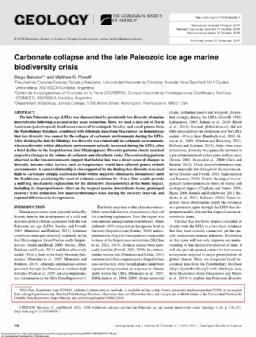| dc.contributor.author | Balseiro, Diego | |
| dc.contributor.author | Powell, Matthew G. | |
| dc.date.accessioned | 2023-06-07T18:32:08Z | |
| dc.date.available | 2023-06-07T18:32:08Z | |
| dc.date.issued | 2020 | |
| dc.identifier.citation | Balseiro, D., and Powell, M.G., 2020, Carbonate collapse and the late Paleozoic ice age marine biodiversity crisis: Geology, v. 48, p. 118–122, https://doi.org/10.1130/G46858.1 | es |
| dc.identifier.uri | http://hdl.handle.net/11086/547692 | |
| dc.description.abstract | The late Paleozoic ice age (LPIA) was characterized by persistently low diversity of marine
invertebrates following a second-order mass extinction. Here, we used a data set of North
American (paleotropical) fossil occurrences of brachiopod, bivalve, and coral genera from
the Paleobiology Database, combined with lithologic data from Macrostrat, to demonstrate
that low diversity was caused by the collapse of carbonate environments during the LPIA.
After dividing the data by lithology, low diversity was evident only in carbonate environments,
whereas diversity within siliciclastic environments actually increased during the LPIA, after
a brief decline in the Serpukhovian (late Mississippian). Diversity patterns closely matched
respective changes in the volume of carbonate and siliciclastic rocks. The contrasting patterns
observed in the two environments suggest that habitat loss was a direct cause of changes in
diversity, because other factors, such as temperature, would have affected genera in both
environments. A causal relationship is also supported by the finding that diversity remained
high in carbonate refugia (carbonate beds within majority-siliciclastic formations) until
the Bashkirian, postdating the onset of icehouse conditions by ∼8 m.y. Our results provide
a unifying, mechanistic explanation for the distinctive characteristics of the biotic impact,
including its disproportionate effect on the tropical marine invertebrate fauna, prolonged
recovery from extinction, low macroevolutionary rates during the recovery interval, and
regional differences in its expression. | es |
| dc.language.iso | eng | es |
| dc.relation.ispartof | 11086/12914 | es |
| dc.rights | Attribution-NonCommercial-NoDerivatives 4.0 Internacional | * |
| dc.rights.uri | http://creativecommons.org/licenses/by-nc-nd/4.0/ | * |
| dc.subject | Geología | es |
| dc.subject | Edad de hielo del Paleozoico | es |
| dc.subject | LPIA | es |
| dc.subject | Paleobiology Database | es |
| dc.subject | Macrostratigraphy | es |
| dc.title | Carbonate collapse and the late Paleozoic ice age marine biodiversity crisis | es |
| dc.type | article | es |
| dc.description.version | info:eu-repo/semantics/publishedVersion | es |
| dc.description.fil | Fil: Balseiro, Diego. Universidad Nacional de Córdoba. Facultad de Ciencias Exactas Físicas y Naturales; Argentina. | es |
| dc.description.fil | Fil: Balseiro, Diego. Consejo Nacional de Investigaciones Científicas y Técnicas. Centro de Investigaciones en Ciencias de la Tierra; Argentina. | es |
| dc.description.fil | Fil: Powelll, Matthew G. Juniata College. Department of Geology; United States of America. | es |
| dc.journal.country | Estados Unidos | es |
| dc.journal.editorial | The Geological Society of America | es |
| dc.journal.number | 2 | es |
| dc.journal.pagination | 118-122 | es |
| dc.journal.title | Geology | es |
| dc.journal.volume | 48 | es |
| dc.identifier.url | https://pubs.geoscienceworld.org/gsa/geology/article/48/2/118/575927/Carbonate-collapse-and-the-late-Paleozoic-ice-age | |
| dc.identifier.url | https://rdu.unc.edu.ar/handle/11086/12914 | |
| dc.identifier.doi | https://doi.org/10.1130/G46858.1 | |





